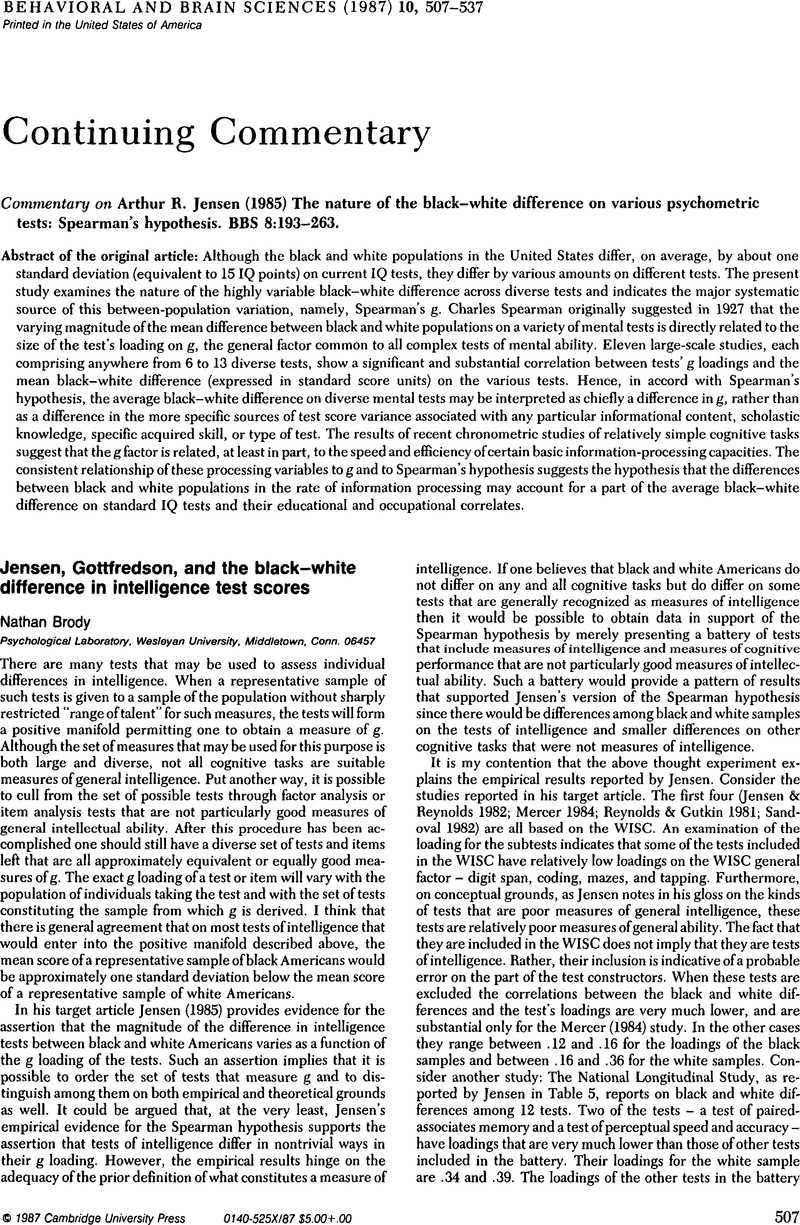Crossref Citations
This article has been cited by the following publications. This list is generated based on data provided by Crossref.
Braden, Jeffery P.
1989.
Fact or artifact? An empirical test of Spearman's Hypothesis.
Intelligence,
Vol. 13,
Issue. 2,
p.
149.
Lipp, H.-P.
1990.
Flechsig's rule and quantitative behavior genetics.
Behavioral and Brain Sciences,
Vol. 13,
Issue. 1,
p.
139.
Chiszar, David A.
and
Gollin, Eugene S.
1990.
Additivity, interaction, and developmental good sense.
Behavioral and Brain Sciences,
Vol. 13,
Issue. 1,
p.
124.
Bookstein, Fred L.
1990.
An interaction effect is not a measurement.
Behavioral and Brain Sciences,
Vol. 13,
Issue. 1,
p.
121.
Wahlsten, Douglas
1990.
Insensitivity of the analysis of variance to heredity-environment interaction.
Behavioral and Brain Sciences,
Vol. 13,
Issue. 1,
p.
109.
Harrington, Gordon M.
1990.
Through the ANOVA looking-glass: Distortions of heredity-environment interactions.
Behavioral and Brain Sciences,
Vol. 13,
Issue. 1,
p.
135.
Goodnight, Charles J.
1990.
On the relativity of quantitative genetic variance components.
Behavioral and Brain Sciences,
Vol. 13,
Issue. 1,
p.
134.
Detterman, Douglas K.
1990.
Don't kill the ANOVA messenger for bearing bad interaction news.
Behavioral and Brain Sciences,
Vol. 13,
Issue. 1,
p.
131.
Kempthorne, Oscar
1990.
How does one apply statistical analysis to our understanding of the development of human relationships.
Behavioral and Brain Sciences,
Vol. 13,
Issue. 1,
p.
138.
Crusio, Wim E.
1990.
Estimating heritabilities in quantitative behavior genetics: A station passed.
Behavioral and Brain Sciences,
Vol. 13,
Issue. 1,
p.
127.
Goodall, Colin
1990.
One statistician's perspective.
Behavioral and Brain Sciences,
Vol. 13,
Issue. 1,
p.
133.
Dudley, R. M.
1990.
Interaction and dependence prevent estimation.
Behavioral and Brain Sciences,
Vol. 13,
Issue. 1,
p.
132.
Henderson, Norman D.
1990.
Who do gene-environment interactions appear more often in laboratory animal studies than in human behavioral genetic research?.
Behavioral and Brain Sciences,
Vol. 13,
Issue. 1,
p.
136.
van Noordwijk, Arie J.
1990.
Variation in means and in ends.
Behavioral and Brain Sciences,
Vol. 13,
Issue. 1,
p.
145.
Maxwell, Scott E.
1990.
Why are interactions so difficult to detect?.
Behavioral and Brain Sciences,
Vol. 13,
Issue. 1,
p.
140.
Wahlsten, Douglas
1990.
Goals and methods: The study of development versus partitioning of variance.
Behavioral and Brain Sciences,
Vol. 13,
Issue. 1,
p.
146.
Carlier, Michèle
and
Marchaland, Catherine
1990.
Interaction between genotype and environment: Yes, but who truly demonstrates this kind of interaction?.
Behavioral and Brain Sciences,
Vol. 13,
Issue. 1,
p.
123.
Kline, Paul
1990.
Heredity and environment: How important is the interaction?.
Behavioral and Brain Sciences,
Vol. 13,
Issue. 1,
p.
139.
Dawes, Robyn M.
1990.
Monotone interactions: It's even simpler than that.
Behavioral and Brain Sciences,
Vol. 13,
Issue. 1,
p.
128.
Cicchetti, Domenic V.
1990.
On the insensitivity of the ANOVA to interactions: Some suggested simulations.
Behavioral and Brain Sciences,
Vol. 13,
Issue. 1,
p.
125.



